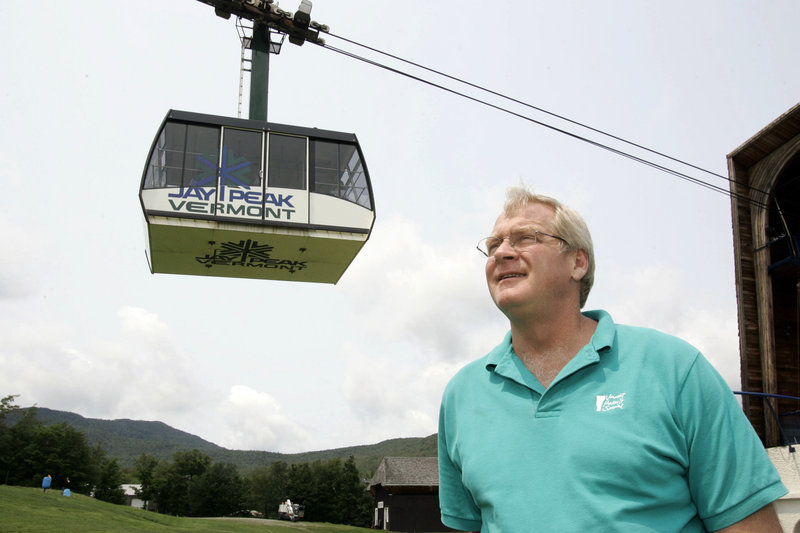MONTPELIER, Vt. – A ski area in northern Vermont and several other points around the country want more officers at border crossings and customs terminals, and they’re willing to pay for it — not because they want to keep anybody out, but to get them in quicker.
The Jay Peak ski resort, the Miami airport and areas along the Mexico border in Texas are among those that want to keep trade and tourists flowing smoothly across the border. They hope they get picked as part of a pilot program that would allow for alternative, supplemental funding of border-crossing services, including private money.
The money could be used to cover salaries of additional staff, overtime and services such as inspections. Customs and Border Protection is reviewing submissions from more than a dozen places around the country and expects to choose five ports of entry this summer.
“On the one hand I don’t think we should have to pay for this extra care, but I’m willing to do it because it just means so much to us,” said Bill Stenger, president of Jay Peak in Jay, Vt., just south of the Quebec line. “I cannot afford to have our guests unnecessarily delayed at the border.”
Border security — and, in particular, the number of border guards to provide it — is a central issue in the immigration debate. But the addition of 20,000 border patrol agents wouldn’t reduce wait times because those officers don’t staff official crossings; they monitor for illegal migration between ports of entry.
The border needs to be safe, but it also needs to be welcoming, Stenger said, “and welcoming means a reasonable time to pass.”
Jay Peak draws 55 percent of its guests from Canada. They have other choices for skiing in Quebec, but Jay Peak’s mountain is higher, with a bigger vertical drop.
Michael De Wolfe, of Montreal, used to cross between Highwater, Quebec, and North Troy, Vt., but has switched to a crossing linking Frelighsburg, Quebec, and West Berkshire, Vt., which is usually faster.
He has a place to stay, so he tends to cross in the late afternoon or evening when it’s not busy. But he said he has encountered waits of 30 minutes on Saturday mornings.
“Those who go to Jay on a regular basis know how to avoid long border waits,” he said by email.
Stenger is willing to pay to have extra staffing at the border on the weekends and holidays, which he estimates would cost about $1,000 a day. But he doesn’t want to do it long-term.
“We have a very good relationship with our border officials, but they have budgetary constraints that they can’t control from here,” Stenger said. “I’m willing to buck up and help pay for it to help them do the job that I know that they want to do but they just haven’t had the resources to do it.”
Ash Ambirge, of Philadelphia, was glad to hear of Miami International Airport’s bid to join the pilot program. She and her husband, who is from Costa Rica, often fly through on their way back from San Jose. The lines are long and the experience unpleasant, she said in an email.
“I would prefer to avoid traveling into Miami in the future, but unfortunately it’s the closest hub to Philadelphia, and it’s also the least expensive,” she said.
Like other government agencies, Customs and Border Protection was subject to the mandatory budget cuts known as sequestration and has encouraged solutions to offset those reductions.
The pilot program will allow for agreements of up to five years. The interested parties and Customs and Border Protection will have written agreements.
Last year, total trade amounted to $493 billion between the U.S. and Mexico and $616 billion between U.S. and Canada, according to the U.S. Census Bureau.
“The border should be viewed as an economic opportunity, not as a threat,” said Democratic U.S. Rep. Beto O’Rourke, of El Paso, Texas, which has submitted a proposal for the pilot program.
El Paso, where the wait at the border can range from 10 minutes to several hours, had tried to tackle the problem itself in 2011 by raising tolls on three international bridges during peak travel times and giving the $2.5 million in extra annual revenue to the Department of Homeland Security for more Customs and Border Protection staff, but the federal agency couldn’t accept separate funding.
The city’s effort and the Cross Border Enhancement Act, which encouraged alternative sources of funding to ease border delays, were the impetus behind the pilot program.
An estimated $92 billion in trade passes through the city’s borders every year, while 6 million people who cross as pedestrians or commuters spend $1.4 billion annually in the local economy, O’Rourke said. Those activities support about 100,000 jobs in the El Paso economy, he said.
Wait times slow trade for some businesses that travel frequently back and forth, for example those that carry products from plants in Mexico to markets in the U.S., said Deputy City Manager Jane Shang.
At least one other entity in Texas, the South Texas Asset Consortium — made up of the cities of Laredo, McAllen and Pharr; Cameron County; and the Starr-Camargo International Bridge Co. — also submitted a proposal for the pilot program for its 11 ports of entry.
Miami International, which sees 9 million to 10 million international arrivals per year, has been discussing for two years the idea of more agents to get international flyers through faster, airport spokesman Greg Chin said.
“We are the fastest-growing U.S. airport for international travel now at MIA,” he said, and staffing “has not been commensurate with that growth.”
Send questions/comments to the editors.



